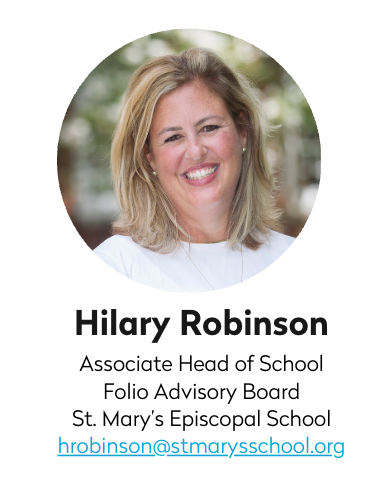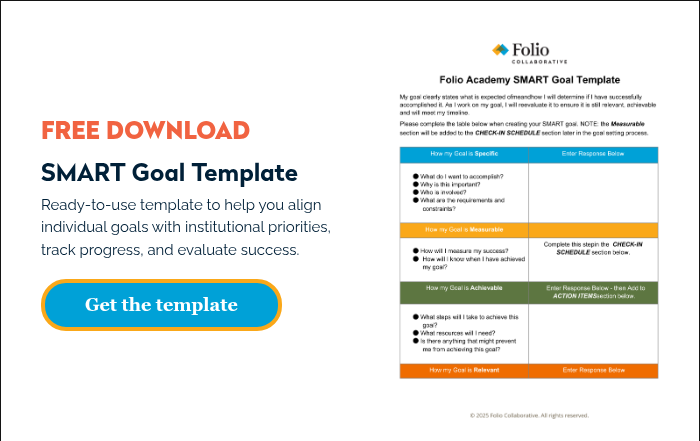Content for this piece comes from the September Folio Spark Session, 'Aligning Teacher Goals for Strategic Impact.'
Our focus today is on a question that is central to meaningful professional growth: How can I structure myFolio to help teachers align their annual goals for strategic impact?

The heart of the work is helping our teachers see how their individual goals connect to something bigger than themselves. Our schools are all working toward ambitious strategic priorities, and Folio gives us a structure to bring those priorities to life in classrooms and in practice. My hope is that you'll come away with a roadmap you can adapt in your own schools, as well as concrete practices for guiding and supporting teachers as they set - and achieve - goals that truly move the needle.
Framing the Work
During our time together, I’m going to walk through how I’ve approached goal-setting at St. Mary’s:
- First, I’ll show you how we connect our strategic plan to Folio themes for the year.
- Then, I’ll talk about how we help faculty set goals within those themes so that they’re both personally meaningful and institutionally impactful.
- Finally, I'll show how I use goal meetings and conversation notes to give feedback, create accountability, and keep that alignment alive throughout the year.
SMS Goal Setting
☑️ Part 1: Annual Themes Are Your Bridge
🔎 Identify your strategic goals.
🗣️ Communicate those goals.
✏️ Create Folio Themes for the year that reflect those goals.
❓ Add a guiding question for each theme.
🔎 Identify your strategic goals.
Thanks to Folio and the book A More Beautiful Question by Warren Berger, the leadership team took our strategic plan a step further by framing each pillar with a guiding question to get us to think about each initiative in an actionable way.
Looking at our strategic initiatives this way triggers our brains to answer these questions, set priorities, and move forward to launch ourselves into the goal setting process. Every goal someone sets for themselves or their classroom ties back to one of these three questions, which in turn moves our strategic plan forward.
SMS Strategic Plan 2025-2030



🗣️ Communicate those goals.
Do not underestimate the importance of communication. Taking the time and care to communicate your school's strategic goals early and often ensures that everyone at your school on the same page and provides necessary clarity and structure to goal setting. As a leadership team, we make it a point to talk about our strategic goals in faculty meetings, on our website, and in team meetings.
✏️ Create Folio Themes for the year that reflect those goals.
❓ Add a guiding question for each theme.
Each year we select Folio Themes that mirror and operationalize our school's strategic plan by writing a guiding question for each strategic goal. Folio Themes allow faculty and non-faculty to align their goals in Folio to school-wide priorities.
For Institutional Excellence, our Folio Theme is 'Pursuing Excellence with Purpose' accompanied by the guiding question, 'How can I refine my professional practice to contribute to a culture of excellence that prepares our students for success?'
For Living Our Episcopal Identity, we chose the theme 'Hospitality and Wholeness' with the guiding question, 'How can I create a classroom culture that values growth, integrity, and hospitality toward all members of our community?'
Finally, we chose 'Community and Connection' to align with Financial Strength and Stability. It was paired with the guiding question, 'How can I strengthen connections across our school community to nurture trust, shared purpose, and understanding among students and colleagues?' This theme could also go with Living Our Episcopal Identity, but we argued that shared purpose, transparency, and understanding will directly impact financial strength and stability and it is something with which everyone on our faculty could actively engage.
The guiding questions are the key because they get teachers thinking about actionable ways they can contribute to larger school goals. They are inviting teachers to see themselves in the school's future.
☑️ Part 2: Help Faculty Set Goals
👏 Encourage teachers to identify professional goals within the Folio Themes.
❓ Use guiding questions like 'How can your work this year advance our collective goal of Institutional Excellence?'
🙌 Honor teacher autonomy by letting them craft goals that are personally meaningful.
🛣️ Guide teachers toward goals that have institutional impact.
When it comes to helping faculty set their goals, my role is really about guiding them toward alignment without taking away their ownership. Sometimes this guidance happens in the actual goals meeting with the division director. Sometimes this is a follow up conversation after goals are submitted.
We start by anchoring goal-setting in the Folio Themes for the year, which are themselves connected to our strategic plan. This gives teachers a clear framework while still leaving plenty of room for choice.
I like to use guiding questions to spark reflection. For example, I might ask, ‘How can your work this year advance our collective goal of institutional excellence?’ or ‘What opportunities do you see to deepen our sense of belonging in your classroom or division?’ These kinds of questions help teachers connect their daily practice to the bigger picture.
At the same time, it’s important to honor teacher autonomy. The goals need to be personally meaningful, otherwise they won’t stick. But I also see my job as making sure those goals don’t just live at the individual level. They need to have institutional impact.
The balance between personal growth and strategic contribution is where the most powerful goals emerge.
☑️ Part 3: Provide Meaningful Feedback
👂 Role of the Leader
- Listen, refine, align
- Offer constructive feedback to ensure goals are SMART (specific, measurable, attainable, relevant, timely).
👥 Conversation Practices
- Ask clarifying questions like, 'What will success look like in May?'
- Connect individual goals back to the strategic plan.
- Acknowledge challenges and suggest strategies to overcome them.
In goal meetings, I focus on creating a collaborative conversation rather than a checklist exercise. I begin by listening carefully to the teacher’s ideas, then work with them to refine and align their goals with our Folio Themes and the school’s strategic priorities.
When offering feedback, I make sure the goals are framed in a SMART way—specific, measurable, attainable, relevant, and timely—so that both the teacher and I can see a clear path forward. Clarifying questions help here, such as, “What will success look like in May?” or “How will you know that this has had the impact you hoped for?”
Throughout the discussion, I intentionally connect the teacher’s individual goals back to the broader mission and strategic plan, so they can see how their growth contributes to institutional excellence. I also acknowledge the challenges they might face, whether logistical, time-related, or resource-based and suggest practical strategies for overcoming those barriers.
These conversations reinforce that professional growth is supported, purposeful, and directly tied to the larger direction of the school.
☑️ Part 4: Ongoing Support and Accountability
📝 Conversation Notes
- Document key points in Folio notes to create continuity and shared accountability.
- Notes should emphasize progress, name challenges, and recenter alignment with strategic goals.
🗓️ Mid Year and End of Year Touchpoints
- Use structured reflection conversations to check alignment and celebrate progress.
- Highlight stories of how faculty goals have driven institutional advancement.
Setting goals is just the starting point. What really matters is how we support teachers in living into those goals throughout the year.
One of the most powerful tools we have for that within myFolio is Conversation Notes. Documenting key points in the platform creates continuity from one meeting to the next and builds shared accountability. Conversation Notes don’t just record what was said, they emphasize progress, name challenges, and always bring the focus back to alignment with our strategic goals.
At SMS, we build in structured touchpoints at mid-year and again at the end of the year. I have teachers complete a formal reflection form at the end of the school year within myFolio. This is where they talk about how the year went, whether or not they achieved their goals or part of their goal, and what they are looking forward to working on going forward. Having a consistent and clear process makes it simple for me to collect examples of strategic alignment in action that I can easily share with senior leadership or members of our board.
The cycle of documenting, reflecting, and celebrating ensures that goal-setting is not a one-time task but an ongoing process that keeps individual growth tied closely to institutional impact.
How Folio Helps
One of the questions I get often is—why Folio? What difference does it make in the life of the school?
For us, Folio provides a clear framework for professional growth. It gives teachers a structured way to reflect on their practice, set goals, and track progress in a way that feels purposeful rather than just another task. It creates consistency across the faculty while still leaving space for individual choice and voice.
Just as importantly, Folio helps ensure alignment. When teachers are setting goals, those goals aren’t floating out on an island. They’re connected directly back to our broader mission and vision.
Folio is the bridge that links an individual’s professional growth with our school’s strategic direction.
Instead of it being a separate or siloed process, Folio helps us weave professional growth right into the fabric of our strategic plan.
Closing Takeaways
I want to leave you with three key ideas that summarize this approach to professional growth, goal setting, and strategic progress.
1. Alignment is intentional. The work doesn’t happen by accident. It’s about being deliberate in connecting the dots from our strategic plan, to the Folio Themes we set each year, to the individual goals our teachers commit to. That alignment is what ensures our professional growth work is moving the school forward in meaningful ways.
2. Feedback is formative. Goal meetings, conversation notes, and touchpoints aren’t just check-ins. They’re opportunities to refine, to realign, and to support teachers as they grow. This ongoing feedback loop is what makes the goals truly actionable and impactful.
3. Impact is collective. When each individual’s growth is connected to the broader mission, all of those small, personal steps add up to something transformational for the institution. That’s the real power of Folio- it turns personal professional growth into collective strategic progress.
CONTINUE YOUR LEARNING
Learn how Fordham Preparatory School leveraged collaboration, myFolio, and a focus on teacher strengths to create a sustainable and personalized PD program that empowers educators and improves student outcomes.



